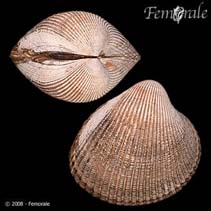Clinocardium nuttallii (Conrad, 1837)
Nuttall cockle| Native range | All suitable habitat | Point map | Year 2050 |

|
| This map was computer-generated and has not yet been reviewed. |
| Clinocardium nuttallii AquaMaps Data sources: GBIF OBIS |
Classification / Names Κοινά ονόματα | Συνώνυμα | CoL | ITIS | WoRMS
Bivalvia | Cardiida | Cardiidae
Environment: milieu / climate zone / εύρος βάθους / distribution range Οικολογία
; εύρος βάθους 0 - 200 m (Αναφ. 114918). Temperate, preferred 5°C (Αναφ. 107945); 68°N - 32°N, 167°W - 164°E
Distribution Χώρες | Περιοχές FAO | Οικοσυστήματα | Παρουσίες | Εισαγωγές
Arctic, Northwest and Eastern Pacific: from California (San Diego), Alaska, Chukchi Sea and Aleutian Islands to Kamchatka and northern Japan (Hokkaido). Subtropical to boreal.
Length at first maturity / Μέγεθος / Weight / Age
Γεννητική Ωρίμανση: Lm ? range ? - ? cm Max length : 14.0 cm SHL αρσενικό/απροσδιόριστο; (Αναφ. 95344); μεγ. αναφερόμενη ηλικία: 18 έτη (Αναφ. 8702)
Life cycle and mating behavior Γεννητική Ωρίμανση | Αναπαραγωγή | Γεννοβολία | Eggs | Γονιμότητα | Larvae
Main reference
Αναφορές | Συντονιστής | Συνεργάτες
GBIF 2007 GBIF data portal. http://newportal.gbif.org. (Αναφ. 8310)
IUCN Red List Status
(Αναφ. 130435: Version 2025-1)
CITES status (Αναφ. 108899)
CMS (Αναφ. 116361)
Threat to humans
Human uses
αλιεία: Εμπορικό(ά)
FAO - αλιεία: landings | FishSource | Η θάλασσα γύρω μας
Εργαλεία
Περισσότερες πληροφορίες
Διαδικτυακές πηγές
BHL | BOLD Systems | CISTI | DiscoverLife | FAO(αλιεία: ; publication : search) | Fishipedia | GenBank (genome, nucleotide) | GloBI | Gomexsi | Google Books | Google Scholar | Google | PubMed | Δέντρο Ζωής | Wikipedia (Go, αναζήτηση) | Zoological Record



